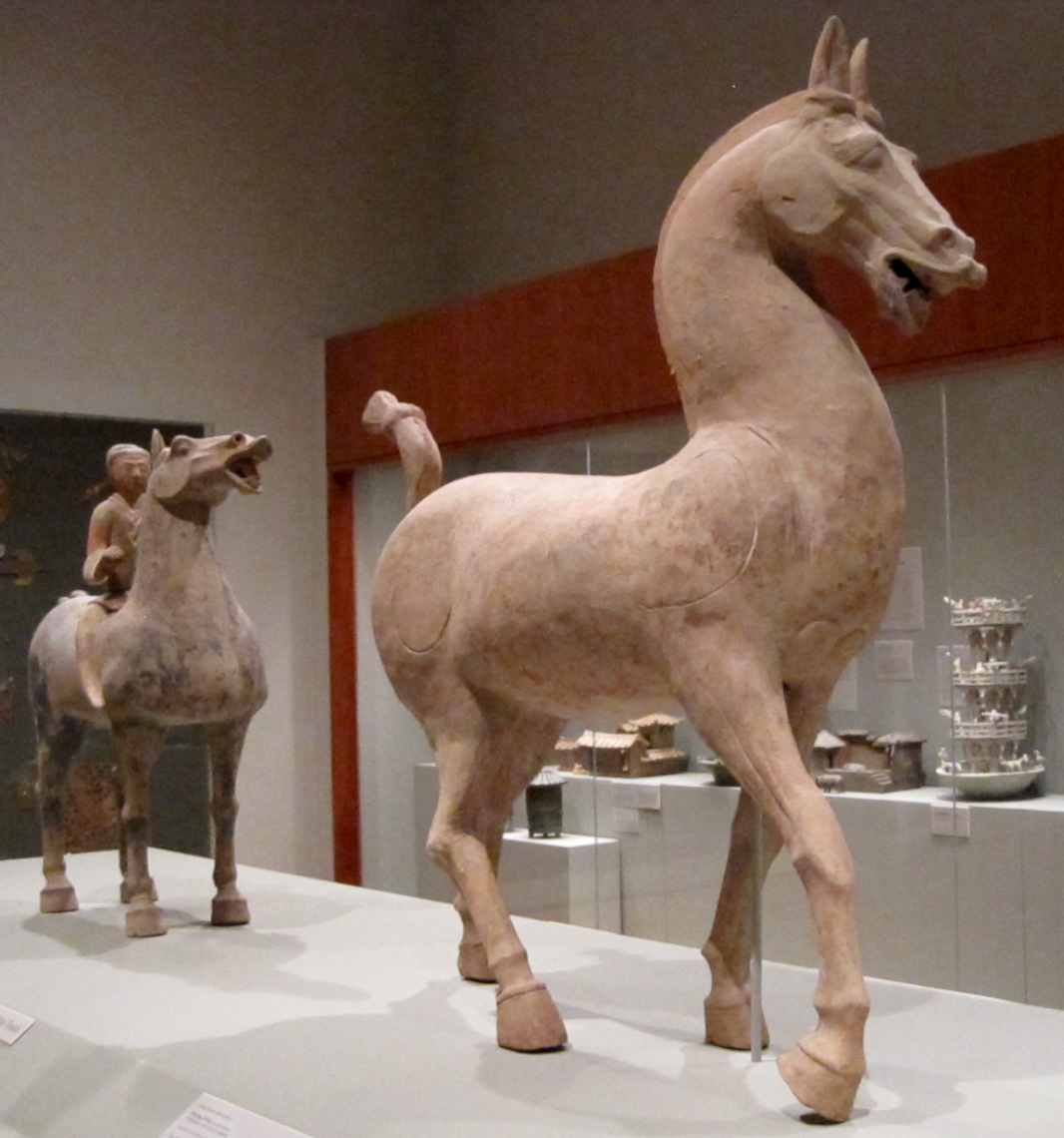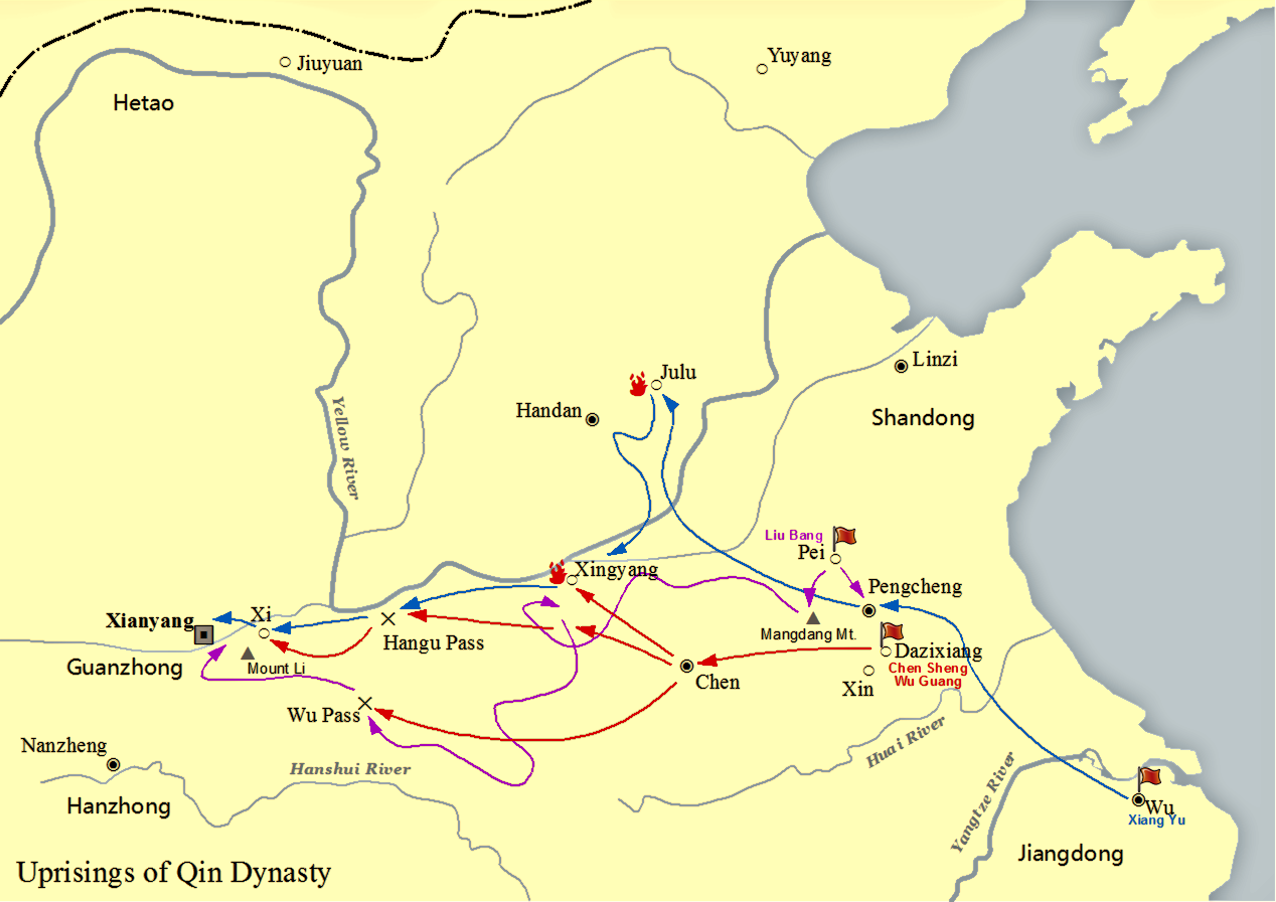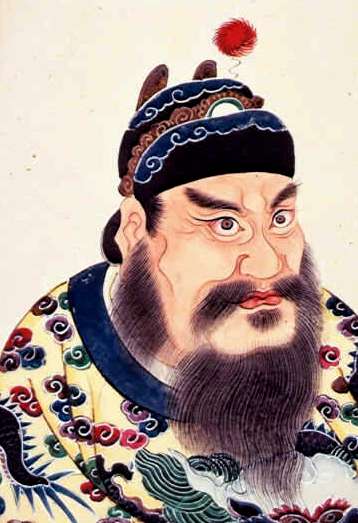|
Southward Expansion Of The Han Dynasty
The southward expansion of the Han dynasty was a series of Chinese military campaigns and expeditions in what is now modern Southern China and Northern Vietnam. Military expansion to the south began under the previous Qin dynasty and continued during the Han era. Campaigns were dispatched to conquer the Yue tribes, leading to the annexation of Minyue by the Han in 135 BC and 111 BC, Nanyue in 111 BC, and Dian in 109 BC. Han Chinese culture took root into the newly conquered territories and the Baiyue and Dian tribes were eventually assimilated or displaced by the Han Empire. Evidence of Han dynasty influences are apparent in artifacts excavated in the Baiyue tombs of modern southern China. This sphere of influence eventually extended to various ancient Southeast Asian kingdoms, where contact led to the spread of Han Chinese culture, trade and political diplomacy. The increased demand for Chinese silk also led to the establishment of the Silk Road connecting Europe, the Ne ... [...More Info...] [...Related Items...] OR: [Wikipedia] [Google] [Baidu] |
Southern China
Northern China () and Southern China () are two approximate regions that display certain differences in terms of their geography, demographics, economy, and culture. Extent The Qinling–Daba Mountains serve as the transition zone between northern and southern China. They approximately coincide with the 0 degree Celsius isotherm in January, the isohyet, and the 2,000-hour sunshine duration contour. The Huai River basin serves a similar role, and the course of the Huaihe has been used to set different policies to the north and the south. History Historically, populations migrated from the north to the south, especially its coastal areas and along major rivers. After the fall of the Han dynasty, The Southern and Northern Dynasties (420–589) ruled their respective part of China before re-uniting under the Tang dynasty. During the Qing dynasty, regional differences and identification in China fostered the growth of regional stereotypes. Such stereotypes often appe ... [...More Info...] [...Related Items...] OR: [Wikipedia] [Google] [Baidu] |
Lingqu Canal
The Lingqu () is a canal in Xing'an County, near Guilin, in the northwestern corner of Guangxi, China. It connects the Xiang River (which flows north into the Yangtze) with the Li River (Guangxi), Li River (which flows south into the Gui River and Xijiang, the latter is one of major tributaries of Pearl River), and thus is part of a historical waterway between the Yangtze and the Pearl River Delta. It was the first canal in the world to connect two river valleys and enabled boats to travel overland between Northern China and the Pearl River Delta. It is also one of the most well-preserved such projects in the world. The canal is long. History In 214 BC, Qin Shi Huang, the First Emperor of the Qin dynasty (221–206 BC), ordered the construction of a canal connecting the Xiang and the Li rivers, in order to Qin invasion of Guangdong, attack the Baiyue tribes in the south. The architect who designed the canal was Shi Lu (). It is the oldest contour canal in the world, r ... [...More Info...] [...Related Items...] OR: [Wikipedia] [Google] [Baidu] |
Model Of Western Han Minyue Palace (33547331351)
A model is an informative representation of an object, person, or system. The term originally denoted the plans of a building in late 16th-century English, and derived via French and Italian ultimately from Latin , . Models can be divided into physical models (e.g. a ship model or a fashion model) and abstract models (e.g. a set of mathematical equations describing the workings of the atmosphere for the purpose of weather forecasting). Abstract or conceptual models are central to philosophy of science. In scholarly research and applied science, a model should not be confused with a theory: while a model seeks only to represent reality with the purpose of better understanding or predicting the world, a theory is more ambitious in that it claims to be an explanation of reality. Types of model ''Model'' in specific contexts As a noun, ''model'' has specific meanings in certain fields, derived from its original meaning of "structural design or layout": * Model (art), a person ... [...More Info...] [...Related Items...] OR: [Wikipedia] [Google] [Baidu] |
Western Han Soldiers 3
Western may refer to: Places *Western, Nebraska, a village in the US *Western, New York, a town in the US * Western Creek, Tasmania, a locality in Australia * Western Junction, Tasmania, a locality in Australia *Western world, countries that identify with shared "Western" culture *Western United States, a region of the United States Arts and entertainment Films * ''Western'' (1997 film), a French road movie directed by Manuel Poirier * ''Western'' (2017 film), a German-Austrian film Genres *Western (genre), a category of fiction and visual art centered on the American Old West **Western fiction, the Western genre as featured in literature **Western film, the western genre in film **Western music (North America), a type of American folk music Music * ''Westerns'' (EP), an EP by Pete Yorn * WSTRN, a British hip hop group from west London *"Western" a song by Black Midi from ''Schlagenheim'' Business * The Western, a closed hotel/casino in Las Vegas, United States *Western Ca ... [...More Info...] [...Related Items...] OR: [Wikipedia] [Google] [Baidu] |
漢武帝
Emperor Wu of Han (156 – 29 March 87BC), born Liu Che and courtesy name Tong, was the seventh Emperor of China, emperor of the Han dynasty from 141 to 87 BC. His reign lasted 54 years – a record not broken until the reign of the Kangxi Emperor more than 1,800 years later – and remains the record for ethnic Han Chinese, Han emperors. His reign resulted in a vast expansion of geopolitical influence for the Sinosphere, Chinese civilization, and the development of a strong centralized state via governmental policies, economical reorganization and promotion of a hybrid legalism (Chinese philosophy), Legalist–Confucianism, Confucian doctrine. In the field of historical social and cultural studies, Emperor Wu is known for his religious innovations and patronage of the poetic and musical arts, including the development of the Music Bureau, Imperial Music Bureau into a prestigious entity. It was also during his reign that cultural contact with western Eurasia was greatly incre ... [...More Info...] [...Related Items...] OR: [Wikipedia] [Google] [Baidu] |
Zhengding County
Zhengding (), originally Zhending (), is a county in southwestern Hebei Province, North China, located approximately south of Beijing, capital of China. It is under the administration of the prefecture-level city of Shijiazhuang, the capital of the province, and has a population of 594,000. Zhengding has been an important religious center for more than 1,000 years, from at least the times of the Sui dynasty to the Qing dynasty. It is the founding place of several major schools of Chan Buddhism. However, many former religious building complexes have been severely damaged throughout history. A noted temple is the Longxing Monastery, where the historical building ensemble has been preserved almost intact. Furthermore, four famous pagodas, each with its own architectural style, are still standing. History Archeological finds indicate that the area of Zhengding County has been settled since the early Neolithic Period. During the Spring and Autumn period, the capital of the Xianyu ... [...More Info...] [...Related Items...] OR: [Wikipedia] [Google] [Baidu] |
Emperor Gaozu Of Han
Emperor Gaozu of Han (2561 June 195 BC), also known by his given name Liu Bang, was the founder and first emperor of the Han dynasty, reigning from 202 to 195 BC. He is considered by traditional Chinese historiography to be one of the greatest emperors in history, credited with establishing the first Pax Sinica, one of China's longest golden ages. Liu Bang was among the few dynastic founders to have been born in a peasant family. He initially entered the Qin dynasty bureaucracy as a minor law enforcement officer in his home town in Pei County, within the conquered state of Chu. During the political chaos following the death of Qin Shi Huang, who had been the first emperor in Chinese history, Liu Bang renounced his civil service position and became a rebel leader, taking up arms against the Qin dynasty. He outmanoeuvred rival rebel leader Xiang Yu to invade the Qin heartland and forced the surrender of the Qin ruler Ziying in 206 BC. After the fall of ... [...More Info...] [...Related Items...] OR: [Wikipedia] [Google] [Baidu] |
Qin Shi Huang
Qin Shi Huang (, ; February 25912 July 210 BC), born Ying Zheng () or Zhao Zheng (), was the founder of the Qin dynasty and the first emperor of China. He is widely regarded as the first ever supreme leader of a unitary state, unitary dynasties of China, dynasty in Chinese history. Rather than maintain the title of "Chinese king, king" ( ) or "suzerain#China, overlord" () borne by the previous rulers of Xia dynasty, Xia, Shang dynasty, Shang and Zhou dynasty, Zhou dynasties, he invented the title of "emperor" ( ), which would see continuous use by Chinese sovereigns and monarchy in China, monarchs for the next two millennia. Ying Zheng was born during the late Warring States period in Handan, the capital of Zhao (state), Zhao, to King Zhuangxiang of Qin, Prince Yiren and Queen Dowager Zhao, Lady Zhao. Prince Yiren was serving as an expendable hostage diplomacy, diplomatic hostage in Zhao at the time, but the wealthy merchant Lü Buwei saw potential in him and lobbied fo ... [...More Info...] [...Related Items...] OR: [Wikipedia] [Google] [Baidu] |
Zhao Tuo
Zhao Tuo (), rendered as Triệu Đà in Vietnamese language, Vietnamese, was a Qin dynasty Chinese general and first emperor of Nanyue. He participated in the conquest of the Baiyue peoples of Guangdong, Guangxi and Northern Vietnam. After the fall of the Qin, he established the independent kingdom of Nanyue with its capital in Panyu (now Guangzhou) in 204 BCE. Some traditional Vietnamese history scholars considered him the founder of the Triệu dynasty while some contemporary historians contest that he was a Han Chinese, foreign invader. Life Nanyue Zhao Tuo was born around in Zhending in the ancient Chinese states, state of Zhao (state), Zhao (within modern Hebei). When the state of Zhao was defeated and annexed by Qin (state) in , Zhao Tuo joined the Qin, serving as one of their generals in the Qin campaign against the Baiyue, conquest of the Baiyue. The territory of those conquered Yues was divided into the three provinces of Guilin, Nanhai, and Xiang. Zhao ser ... [...More Info...] [...Related Items...] OR: [Wikipedia] [Google] [Baidu] |
Zhejiang
) , translit_lang1_type2 = , translit_lang1_info2 = ( Hangzhounese) ( Ningbonese) (Wenzhounese) , image_skyline = 玉甑峰全貌 - panoramio.jpg , image_caption = View of the Yandang Mountains , image_map = Zhejiang in China (+all claims hatched).svg , mapsize = 275px , map_caption = Location of Zhejiang in China , coordinates = , subdivision_type = Country , subdivision_name = China , named_for = Old name of Qiantang River , seat_type = Capital and largest city , seat = Hangzhou , established_title = Annexation by the Qin dynasty , established_date = 222 BC , established_title2 = Jiangnandong Circuit , established_date2 = 626 , established_title3 = Liangzhe Circuit , established_date3 = 997 , established_title4 = Zhejiang Province formed , established_date4 = 1368 , established_title5 = Republican Period , established_date5 = 1 January 1912 , established_title6 ... [...More Info...] [...Related Items...] OR: [Wikipedia] [Google] [Baidu] |
Dong'ou Kingdom
Dong'ou () also known as Ouyue (), was an ancient kingdom in modern Wenzhou and Taizhou, Zhejiang Province, China. The realm of Dong'ou was given to Zou Yao by Emperor Gaozu of Han Emperor Gaozu of Han (2561 June 195 BC), also known by his given name Liu Bang, was the founder and first emperor of the Han dynasty, reigning from 202 to 195 BC. He is considered by traditional Chinese historiography to be one o ... in 192 BC. During the Han campaigns against Minyue in 138 BC, the king of Dong'ou no longer wished to live in his realm after the incident, having submitted himself in an prostrating gesture, which was indicative of his final acquiescence as a mere supplicant to have him and his people's eventual fates to be absorbed into the Han empire. After Zou Yushan's unsuccessful uprising against General Yang Pu's conspiratorial intentions to subvert him, which aimed to protect Dongyue's independence, the aspiration for autonomous control over Dongyue gradually ... [...More Info...] [...Related Items...] OR: [Wikipedia] [Google] [Baidu] |
Fujian
Fujian is a provinces of China, province in East China, southeastern China. Fujian is bordered by Zhejiang to the north, Jiangxi to the west, Guangdong to the south, and the Taiwan Strait to the east. Its capital is Fuzhou and its largest prefecture city by population is Quanzhou, with other notable cities including the port city of Xiamen and Zhangzhou. Fujian is located on the west coast of the Taiwan Strait as the closest province geographically and culturally to Taiwan; as a result of the Chinese Civil War, a small portion of historical Fujian is administered by Taiwan, romanized as Fuchien Province, Republic of China, Fuchien. While the population predominantly identifies as Han Chinese, Han, it is one of China's most culturally and linguistically diverse provinces. The dialects of the language group Min Chinese are most commonly spoken within the province, including the Fuzhou dialect and Eastern Min of Northeastern Fujian province and various Southern Min and Hokkien dial ... [...More Info...] [...Related Items...] OR: [Wikipedia] [Google] [Baidu] |






